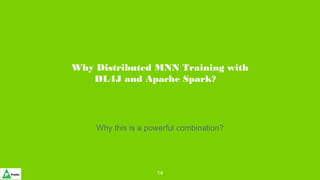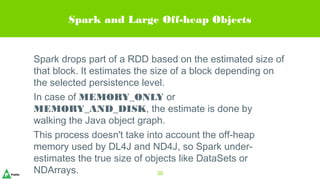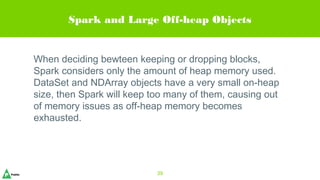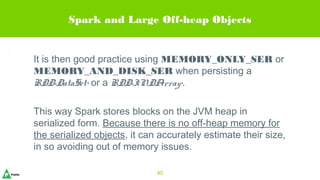Deep Learning with DL4J on Apache Spark: Yeah it's Cool, but are You Doing it the Right Way?
DeepLearning4J (DL4J) is a powerful Open Source distributed framework that brings Deep Learning to the JVM (it can serve as a DIY tool for Java, Scala, Clojure and Kotlin programmers). It can be used on distributed GPUs and CPUs. It is integrated with Hadoop and Apache Spark. ND4J is a Open Source, distributed and GPU-enabled library that brings the intuitive scientific computing tools of the Python community to the JVM. Training neural network models using DL4J, ND4J and Spark is a powerful combination, but the overall cluster configuration can present some unespected issues that can compromise performances and nullify the benefits of well written code and good model design. In this talk I will walk through some of those problems and will present some best practices to prevent them. The presented use cases will refer to DL4J and ND4J on different Spark deployment modes (standalone, YARN, Kubernetes). The reference programming language for any code example would be Scala, but no preliminary Scala knowledge is mandatory in order to better understanding the presented topics.




















































Recommended




























































More Related Content
What's hot (20)








































Similar to Deep Learning with DL4J on Apache Spark: Yeah it's Cool, but are You Doing it the Right Way? (20)


































More from DataWorks Summit (20)






































Recently uploaded (20)




































Deep Learning with DL4J on Apache Spark: Yeah it's Cool, but are You Doing it the Right Way?
- 1. Deep Learning with DL4J on Apache Spark: Yeah it's Cool, but are You Doing it the Right Way?
- 2. Hello! I am Guglielmo Iozzia Associate Director – Business Tech Analysis at Previuosly at 2
- 3. MSD in Ireland + 50 years Approx. 2,000 employees Five sites: Ballydine, Brinny, Carlow and Dublin $2.5 billion investment to date Approx 50% MSD’s top 20 products manufactured here Export to + 60 countries €6.1 billion turnover in 2017 2017 + 300 jobs & €280m investment MSD Biotech, Dublin, coming in 2021
- 4. Deep Learning It is a subset of machine learning where artificial neural networks, algorithms inspired by the human brain, learn from large amounts of data. 4
- 5. Some Practical Applications of Deep Learning × Computer vision × Text generation × NLP and NLU × Autonomous cars × Robotics × Gaming × Quantitative finance 5
- 6. DL4J It is an Open Source, distributed, Deep Learning framework written for JVM languages. 6
- 7. It is integrated with Hadoop and Apache Spark and can be used on distributed GPUs and CPUs. 7
- 8. DL4J Modules × DataVec × Arbiter × NN × Datasets × RL4J × DL4J-Spark × ND4J 8
- 9. DL4J Code Example 9 Training and Evaluation Network Configuration
- 10. ND4J It is an Open Source linear algebra and matrix manipulation library which supports n-dimensional arrays and it is integrated with Apache Hadoop and Spark. 10
- 11. Apache Spark It is a unified analytics engine for large-scale data processing. 11
- 12. Speed Apache Spark achieves high performance for both batch and streaming data, using a state-of-the-art DAG scheduler, a query optimizer, and a physical execution engine. Apache Spark Ease of Use Write applications quickly in Java, Scala, Python, R and SQL. 12
- 13. Generality Spark provides a stack of libraries that can be combined seamlessly in the same application. Apache Spark Runs Everywhere Spark runs on Hadoop, Apache Mesos, Kubernetes, standalone or in the cloud. It can access diverse data sources. 13
- 14. Why Distributed MNN Training with DL4J and Apache Spark? Why this is a powerful combination? 14
- 15. DL4J + Apache Spark × DL4J provides high level API to design, configure train and evaluate MNNs. × Spark performances are excellent in particular for ETL/streaming, but in terms of computation, in a MNN training context, some data transformation/aggregation need to be done using a low-level language. × DL4J uses ND4J, which is a C++ library that provides high level Scala API to developers. 15
- 16. Model Parallelization DL4J + Apache Spark Data Parallelization 16
- 17. So: What could possibly go wrong? 17
- 18. Memory Management And now, for something (a little bit) different. 18
- 19. Memory Utilization at Training Time 19
- 20. Memory Management in DL4J Memory allocations can be managed using two different approaches: ×JVM GC and WeakReference tracking ×MemoryWorkspaces The idea behind both is the same: once a NDArray is no longer required, the off-heap memory associated with it should be released so that it can be reused. 20
- 21. Memory Management in DL4J The difference between the two approaches is: ×JVM GC: when a INDArray is collected by the garbage collector, its off-heap memory is deallocated, with the assumption that it is not used elsewhere. ×MemoryWorkspaces: when a INDArray leaves the workspace scope, its off-heap memory may be reused, without deallocation and reallocation. 21
- 22. Memory Management in DL4J Please remember that, when a training process uses workspaces, in order to get the most from this approach, periodic GC calls need to be disabled: Nd4j.getMemoryManager.togglePeriodicGc(false) or their frequency needs to be reduced: val gcInterval = 10000 // In milliseconds Nd4j.getMemoryManager.setAutoGcWindow(gcInterval) 22
- 23. Spark & the DL4J Web UI A love/hate relationship. 23
- 24. The DL4J Training UI 24
- 25. Root Cause and Potential Solutions Dependencies conflict between the DL4J-UI library and Apache Spark when running in the same JVM. Two alternatives are available: ×Collect and save the relevant training stats at runtime, and then visualize them offline later. ×Execute the UI and use its remote functionality into separate JVMs (servers). Metrics are uploaded from the Spark master to the UI server. 25
- 26. Serialization & ND4J Kryo me a river. 26
- 27. Data Serialization Options in Spark Data Serialization is the process of converting the in- memory objects to another format that can be used to store or send them over the network. Two options available in Spark: ×Java (default) ×Kryo 27
- 28. OOOps!!! Kryo doesn’t work well with off-heap data structures. 28
- 29. How to Use Kryo Serialization with ND4J? ×Add the ND4J-Kryo dependency to the project ×Configure the Spark application to use the ND4J Kryo Registrator: val sparkConf = new SparkConf sparkConf.set("spark.serializer", "org.apache.spark.serializer.KryoSerializer") sparkConf.set("spark.kryo.registrator", "org.nd4j.Nd4jRegistrator") 29
- 30. Data Locality How data locality affects performance? 30
- 31. Data Locality in Spark Data locality in Spark means doing computation on the node where data resides. In order to optimize processing tasks, Spark tries to place the execution code as close as possible to the processed data. ×It tries first to move serialized code to the data. ×Sometimes this isn’t possible and the data must be moved to the executor. 31
- 32. Data Locality in Spark How Spark handles data locality? ×It prefers to schedule all tasks at the best locality level. ×When there is no unprocessed data on any idle executor, it switches to lower locality levels. − It can wait until a busy CPU frees up to start a task on data on the same server. − It can immediately start a new task in a farther place that requires moving data there. 32
- 33. Data Locality in Spark Spark typically waits a bit in the hopes that a busy CPU frees up. Once that timeout (default is 3 sec) expires, it starts moving the data to the free CPU. But: ×Training neural networks with DL4J is computationally expensive. ×So the Spark default behavior isn’t an ideal fit for maximizing cluster utilization. 33
- 34. Data Locality in Spark and DL4J During training on Spark, DL4J ensures that there is exactly one task per executor: so it is always better to immediately transfer data to a free executor, rather than waiting for another one to become free. Computation time is more important than any network transfer time. 34
- 35. Data Locality in Spark and DL4J Spark provides the spark.locality.wait configuration property: it is the timeout (in seconds) to wait before moving data to a free CPU. So, when submitting the configuration for a DL4J training app, we have to set the value of the spark.locality.wait property to 0. 35
- 36. Handling Java Objects with Large Off-heap Components The Off-heap, again. 36
- 37. Spark and Large Off-heap Objects Spark has problems handling Java objects with large off- heap components, in particular in caching or persisting them. When working with DL4J, this is a frequent case, as DataSet and NDArray objects are involved. 37
- 38. Spark and Large Off-heap Objects Spark drops part of a RDD based on the estimated size of that block. It estimates the size of a block depending on the selected persistence level. In case of MEMORY_ONLY or MEMORY_AND_DISK, the estimate is done by walking the Java object graph. This process doesn't take into account the off-heap memory used by DL4J and ND4J, so Spark under- estimates the true size of objects like DataSets or NDArrays. 38
- 39. Spark and Large Off-heap Objects When deciding bewteen keeping or dropping blocks, Spark considers only the amount of heap memory used. DataSet and NDArray objects have a very small on-heap size, then Spark will keep too many of them, causing out of memory issues as off-heap memory becomes exhausted. 39
- 40. Spark and Large Off-heap Objects It is then good practice using MEMORY_ONLY_SER or MEMORY_AND_DISK_SER when persisting a RDD<DataSet> or a RDD<INDArray>. This way Spark stores blocks on the JVM heap in serialized form. Because there is no off-heap memory for the serialized objects, it can accurately estimate their size, in so avoiding out of memory issues. 40
- 41. Image Pipeline Data Preparation One Batch, Two Batch (Penny and Dime) 41
- 42. Convolutional Neural Network (CNN) 42 By Aphex34 - Own work, CC BY-SA 4.0, https://commons.wikimedia.org/w/index.php?curid=45679374
- 43. Single Machine You can use DataVec’s ImageRecordReader. Image Pipeline Data Preparation Spark Cluster Image preprocessing. 43
- 44. Image Pipeline Data Preparation The Spark strategy assume the images are in subdirectories based on their class labels. Example: imageRootDir/car/img0.jpg imageRootDir/car/img1.jpg ... imageRootDir/truck/img0.jpg imageRootDir/truck/img1.jpg ... imageRootDir/motorbike/img0.jpg imageRootDir/motorbike/img1.jpg ... 44
- 45. Image Pipeline Data Preparation (Spark) The approach is to preprocess the images into batches of files (ND4J’s FileBatch objects). The motivation: the original image files typically use efficient compression (JPEG, PNG, other) which is much more space and network efficient than a bitmap representation. However, on a cluster we want to minimize disk reads due to latency issues with remote storage – one single file read/transfer is faster than multiple remote file reads. 45
- 46. Image Pipeline Data Preparation (Spark) Step 1 (option 1): Preprocess images locally. val sourceDirectory = "/home/guglielmo/training_images" val destinationDirectory = "/home/guglielmo/preprocessed_images" val batchSize = 32 SparkDataUtils.createFileBatchesLocal(sourceDirectory, NativeImageLoader.ALLOWED_FORMATS, true, destinationDirectory, batchSize) After the preprocessing completes, the destination directory can be copied to the cluster. 46
- 47. Image Pipeline Data Preparation (Spark) Step 1 (option 2): Preprocess images using Spark. val sourceDirectory = “hdfs:///data/training_images” val destinationDirectory = “hdfs:///data/preprocessed_images” val batchSize = 32 SparkDataUtils.createFileBatchesSpark(sourceDirectory, destinationDirectory, batchSize, sparkContext) 47
- 48. Image Pipeline Data Preparation (Spark) Step 2: Create a data loader... val imageHeightWidth = 64 val imageChannels = 3 val labelMaker:PathLabelGenerator = new ParentPathLabelGenerator val rr = new ImageRecordReader(imageHeightWidth, imageHeightWidth, imageChannels, labelMaker) rr.setLabels(new TinyImageNetDataSetIterator(1).getLabels) val numClasses = TinyImageNetFetcher.NUM_LABELS val loader = new RecordReaderFileBatchLoader(rr, minibatch, 1, numClasses) loader.setPreProcessor(new ImagePreProcessingScaler) 48
- 49. Image Pipeline Data Preparation (Spark) Step 2: ...and finally train the model val trainDataPath = "hdfs:///data/preprocessed_images" val pathsTrain:JavaRDD<String> = SparkUtils.listPaths(sparkContext, trainDataPath) for (i <- 0 until numEpochs) { sparkNet.fitPaths(pathsTrain, loader) } 49
- 50. All the Details on DL4J and Spark in my Book http://tinyurl.com/y9jkvtuy 50
- 51. Thanks! Any questions? You can find me at @guglielmoiozzia https://ie.linkedin.com/in/giozzia googlielmo.blogspot.com 51
- 52. Credits Special thanks to all the people who made and released these awesome resources for free: ×Presentation template by SlidesCarnival 52
Editor's Notes
- #5: The field of artificial is essentially when machines can do tasks that typically require human intelligence. It encompasses machine learning, where machines can learn by experience and acquire skills without human involvement. Deep learning is a subset of machintelligenceine learning where artificial neural networks, algorithms inspired by the human brain, learn from large amounts of data. Similarly to how we learn from experience, the deep learning algorithm would perform a task repeatedly, each time tweaking it a little to improve the outcome. We refer to ‘deep learning’ because the neural networks have various (deep) layers that enable learning. Just about any problem that requires “thought” to figure out is a problem deep learning can learn to solve.
- #6: http://www.yaronhadad.com/deep-learning-most-amazing-applications/





